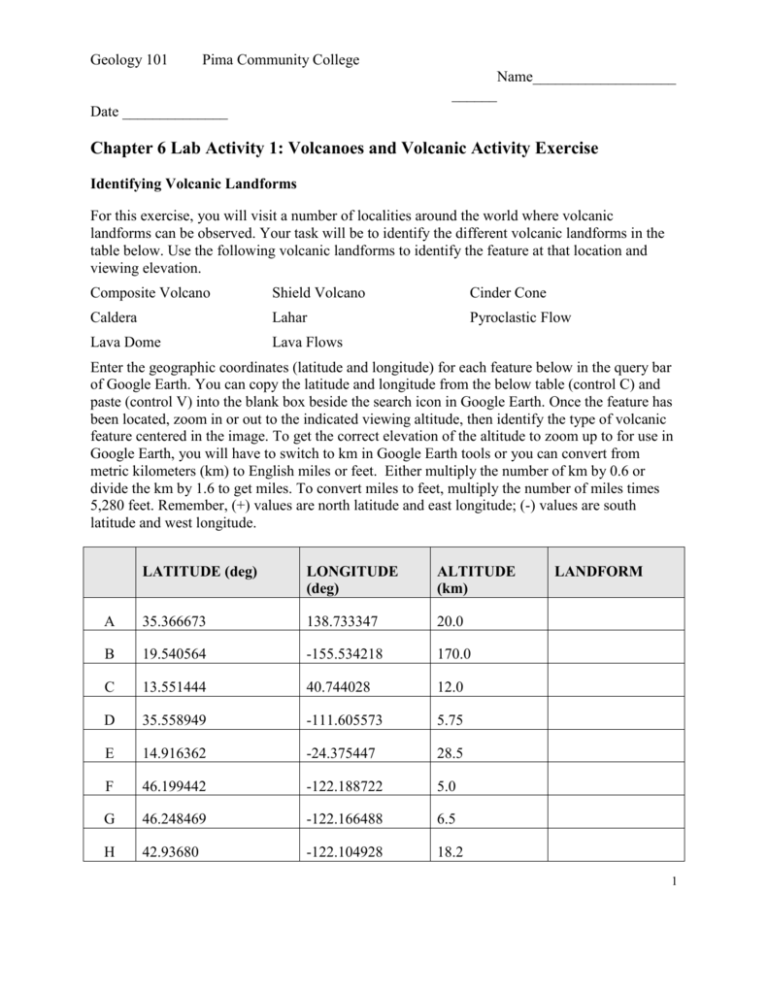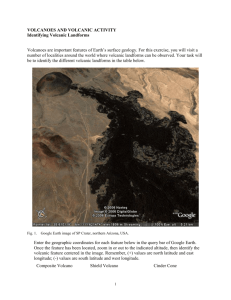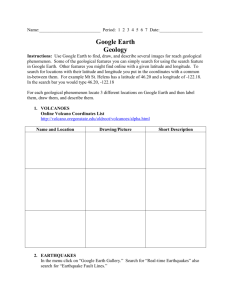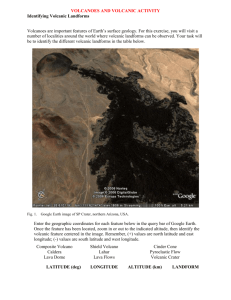Volcanoes Google Earth lab
advertisement

Geology 101 Pima Community College Name___________________ ______ Date ______________ Chapter 6 Lab Activity 1: Volcanoes and Volcanic Activity Exercise Identifying Volcanic Landforms For this exercise, you will visit a number of localities around the world where volcanic landforms can be observed. Your task will be to identify the different volcanic landforms in the table below. Use the following volcanic landforms to identify the feature at that location and viewing elevation. Composite Volcano Shield Volcano Cinder Cone Caldera Lahar Pyroclastic Flow Lava Dome Lava Flows Enter the geographic coordinates (latitude and longitude) for each feature below in the query bar of Google Earth. You can copy the latitude and longitude from the below table (control C) and paste (control V) into the blank box beside the search icon in Google Earth. Once the feature has been located, zoom in or out to the indicated viewing altitude, then identify the type of volcanic feature centered in the image. To get the correct elevation of the altitude to zoom up to for use in Google Earth, you will have to switch to km in Google Earth tools or you can convert from metric kilometers (km) to English miles or feet. Either multiply the number of km by 0.6 or divide the km by 1.6 to get miles. To convert miles to feet, multiply the number of miles times 5,280 feet. Remember, (+) values are north latitude and east longitude; (-) values are south latitude and west longitude. LATITUDE (deg) LONGITUDE (deg) ALTITUDE (km) A 35.366673 138.733347 20.0 B 19.540564 -155.534218 170.0 C 13.551444 40.744028 12.0 D 35.558949 -111.605573 5.75 E 14.916362 -24.375447 28.5 F 46.199442 -122.188722 5.0 G 46.248469 -122.166488 6.5 H 42.93680 -122.104928 18.2 LANDFORM 1 I 41.587152 -122.474640 14.8 J 14.986742 120.222811 14 Additional Questions: 1. What type of volcanic rocks would you expect to be erupted from ‘B’ above? 2. Of what type volcanic rock do you think the feature in ‘F’ is composed? 3. Use the ‘Measure’ or ‘Ruler’ tool in Google Earth to estimate the diameter of the feature in ‘H’. What is the diameter of this feature? 4. The feature in ‘H’ is approximately circular. What is its area? Use the formula for area of a circle (A = r2, where radius r = 1/2 diameter and = 3.14). 5. Use the ‘Measure’ or ‘Ruler’ tool in Google Earth to determine the distance from the feature in ‘I’ and the summit of its parent volcano. How far is it? 6. Use the ‘Measure’ or ‘Ruler’ tool in Google Earth to determine the distance from the feature in ‘J’ and the summit of its parent volcano. How far is it? 7. Find a composite volcano (stratovolcano) that is not featured above; save and print the image with a brief description of it for your instructor. 8. Find a shield volcano that is not featured above; save and print the image with a brief description of it to upload as a .jpg or .pdf file for your instructor. Links to Related Sites: Wikipedia entry on shield volcanoes: http://en.wikipedia.org/wiki/Shield_volcano Wikipedia entry on composite volcanoes: http://en.wikipedia.org/wiki/Composite_volcano Wikipedia entry on lava flows: http://en.wikipedia.org/wiki/Lava_flow Wikipedia entry on calderas: http://en.wikipedia.org/wiki/Caldera Wikipedia entry on pyroclastic flows: http://en.wikipedia.org/wiki/Pyroclastic_flow Wikipedia entry on lahars: http://en.wikipedia.org/wiki/Lahar Wikipedia entry on cinder cones: http://en.wikipedia.org/wiki/Cinder_cone 2








